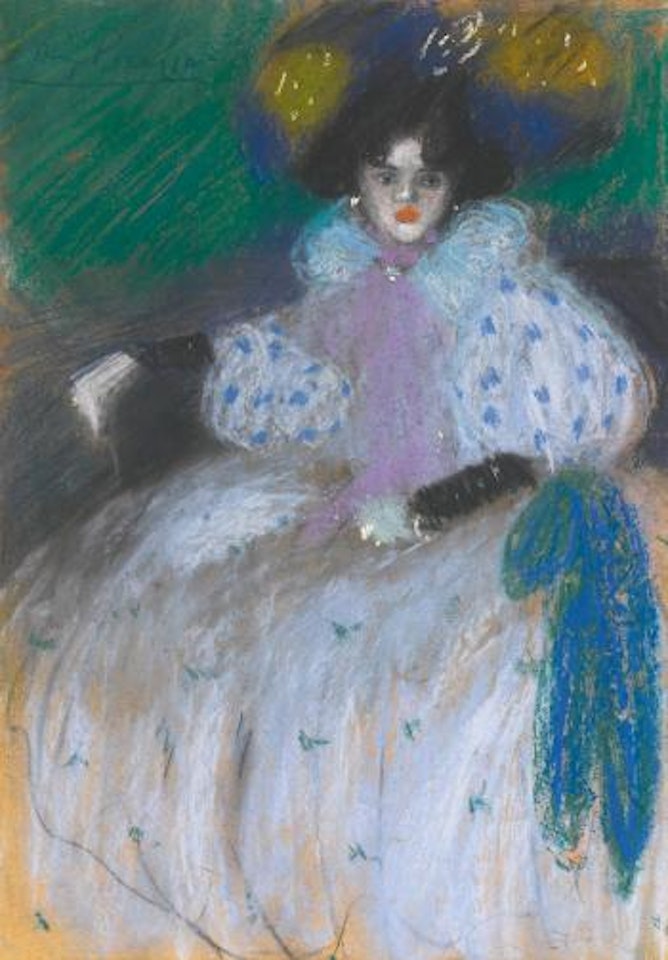Note: '1901 was undoubtedly a seminal year for Picasso, and his bold entrance into the Paris art world - "the Spanish invasion" as one critic had it - set the tone for his future practice.' Barnaby Wright in Becoming Picasso: Paris 1901 (exhibition catalogue), The Courtauld Gallery, London, 2013, p. 13 Femme assise, executed in Madrid in 1901, is one of Picasso’s most vibrant works from his important series depicting elaborately frocked courtesans. In December 1900 Picasso returned to Spain from his first trip to Paris, which he had visited with his friends Carlos Casagemas and Manuel Pallarcs. In January 1901 the artist moved back to Madrid, the city where he had studied in 1897-98, and founded the art journal Art Joven together with Francisco de Asis Soler. Picasso remained in the Spanish capital until May, drawing for his fledgling magazine and feverishly executing several lush and brilliantly coloured paintings and pastels featuring over-dressed women (figs. 1-3). The radical young painter created these dramatic images as a provocative response to the artistic establishment, which for some time nurtured a trend for nostalgic historical genre painting.This group would prove to be far more influential than perhaps the artist himself had expected, for they inspired the work he showed a few months later in Paris at the gallery of the esteemed Impressionist dealer Ambroise Vollard. Picasso's emergence on the Parisian artistic scene was hailed by artists and critics alike. Femme assise is closely related to the 1901 oil painting La femme en bleu (fig. 1) which was exhibited that year in Madrid. These two works feature a similar model and approach to the colouring and structure of the composition. With regard to the subject, Josep Palau i Fabre has noted: ‘Different from one another though they may be, and with certain variations of details, [the women of Madrid] have one feature in common, for they all, almost without exception, wear particularly enormous skirts that are only suitable for walking straight from the carriage to the drawing room and, once that haven has been reached, for moving as little as possible from the sofas on which we often see them sitting’ (J. Palau i Fabre, op. cit., p. 219).Commenting on the series of works to which this pastel belongs, John Richardson has written: ‘These are oddly Parisian in feeling; hard-faced cocottes in crinolines so bouffant that the wearer takes up an entire sofa.. the largest and most ambitious of these courtesans is the Lady in Blue [fig. 1], which portrays a hieratic dominatrix, heavily made up like the Moulin de la Galette women, dressed in a late nineteenth-century version of an eighteenth-century costume: an enormous hat, an enormous butterfly bow and an enormous white crinoline embroidered in silver swags.. The Madrid courtesan pictures are an exception to the general rule that Picasso's style and subject matter reflect his way of life. There was not much of a gilded demi-monde in Madrid (people went to Paris for that), but even if there had been Picasso would not have had access to it. He drew partly on fantasy, partly on the vision of other artists (e.g. Toulouse-Lautrec, Steinlen and Bottini) and partly on his memories of la vie parisienne - not least the magazine of that name that celebrated the charms of the grandes cocottes. The impact of Goya is also apparent, above all in the more grotesque paintings: the Old Harlot and the Dwarf Dancer. No matter whether these works were done in Madrid or Barcelona or Paris, or as I believe, started in Madrid and finished in Paris (spring-early summer 1901), they are the first manifestations of the combinations of compassion and grotesquerie, and the notion of conventional beauty as a sham that Picasso derived from Goya’ (J. Richardson, A Life of Picasso, London, 1991, vol. I, p. 182). The first owner of this work was Ramon Casas (1866-1932), a Catalan painter whom Picasso met in the late 1890s. Casas, who was one of the leading artists of the Modernista movement, was a great influence on Picasso and in 1900 he organised, together with Miquel Utrillo and Santiago Rusifiol, Picasso's first exhibition in the bohemian tavern Els Quatre Gats in Barcelona. A year later, before leaving for Paris in the late spring-early summer of 1901, Picasso included some of his works at the prestigious Sala Pares in Barcelona, where his pastels hung together with the work of his mentor Casas and other Modernista painters. Little is known about this exhibition, which paired Spain's then most eminent avant-garde artist with the upstart Picasso. Although the exhibition was originally intended to concentrate on Casas, Miquel Utrillo instead lavished his praise on the young artist in one of the show's few surviving reviews: ‘Picasso's art is very youthful: the fruit of a spirit of observation that does not forgive the weakness of people today, it comes out even with terrible beauties, recorded with the sobriety of one who draws because he sees [..] the pastels appearing in the exhibition [..] in the Sala Pares are just one fact of Picasso's talent. [..] Picasso has inspired in his French colleagues the well-intended name of Petit Goya. We hope he lives up to his appearance and at the heart we know he will not let us down’ (quoted in J. Palau i Fabre, op. cit., p. 185).


